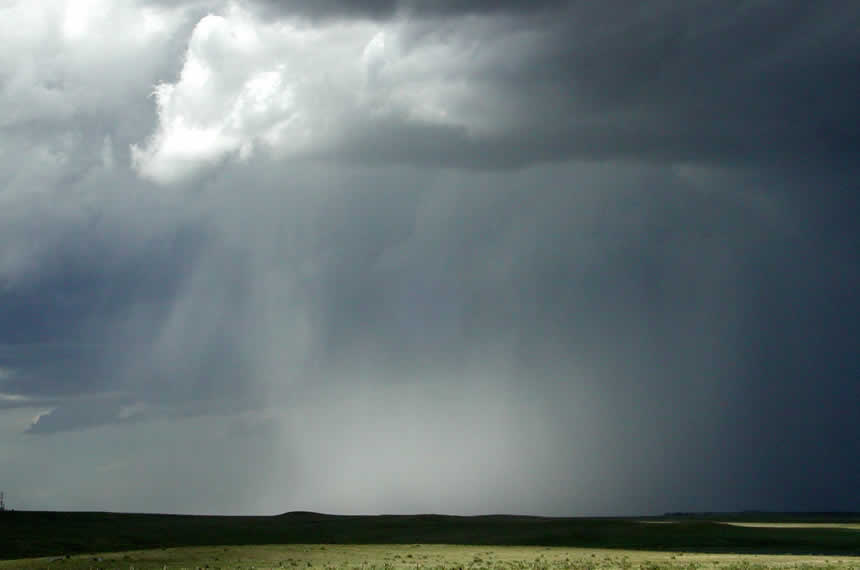A thunderstorm is an electrical weather phenomenon in which heavy rain comes together with flashes of lighting, strong winds and potential hail and tornadoes. They most often occur during sultry hot summer days, but to a much lesser extent can also appear during winter, because the air in the atmosphere during the cold season is more stable than during the hot season.
An isolated thunderstorm may last approximately one hour, and cover an area between 5 to 9 square kilometers. When several thunderstorms come or form in succession it is called a depression. A depression is an area with low atmospheric pressure, and can extend over several hundred kilometers. Approximately 16 million thunderstorms occur all around the world each year, but only about 100,000 of those occur in the United States. In fact even at this moment there are about 2,000 thunderstorms under way.
Thunderstorm Fast Facts
- There are approximately 2,000 thunderstorms occuring on Earth at any given moment.
- A necessary condition that must be present for a thunderstorm to occur is an unstable atmosphere, which is caused by convection currents and temperature differences.
- The clouds that form prior to and during these events are called cumulonimbus clouds.
- Hail, lightning, thunder and tornadoes are all products of thunderstorms.
What causes a thunderstorm to occur?
Thunderstorms originate when the atmosphere presents a certain set of conditions. First, large masses of warm, moist air with water vapor rise through layers of colder air. These are called convection currents.
As the masses of air move up, they leave space behind that is filled by cold air, which is denser as it contains more molecules in the same amount of area.
These masses of air circulate in the same manner that air bubbles do at the bottom of a kettle of boiling water. The heated floor increases the temperature of the air that is in contact with it. This heated air is lighter and less dense than the air in the layer right above it, and it begins to push upwards.
As the heated air rises, it also expands, and, as it expands, it loses heat. Though this pocket of air is slightly colder than it was before, it continues to push upwards because the surrounding layers of air that the ascending air traverses are still colder and denser.
When the rising air has cooled to the point that it cannot maintain all the water molecules that it contains in the gaseous state (water vapor), the water vapor condenses into millions of tiny drops of water floating in the air. The tiny drops form the massive, if not beautiful, clouds ready to start the thunderstorm.
These clouds that form at the onset of thunderstorms are called cumulonimbus or deep cumulus clouds. A person can easily identify them because they look like giant mushrooms or anvils, with a major difference between them and other cloud types being that they are much, much bigger.
The bottoms of these massive clouds are typically between 300 and 900 meters above the ground. In very dry regions, these clouds can rise to heights between 4 to 8 kilometers. In more humid regions of the Earth around the equator, these clouds can reach heights of 11 to 15 kilometers above the surface.
Energy in the form of heat is released when the water vapor condenses. This extra heat increases the temperature of the air surrounding the condensing water vapor, and pushes the rising mass of air even higher.
A critical condition needed for a thunderstorm to evolve is that the temperature of the surrounding environment of the convection currents decrease more rapidly than the temperature of the rising air within the current. If this condition is met, the atmosphere is said to be unstable.
The water vapor in the convection currents reaches an altitude where the temperature of the ascending current becomes so low that the tiny water droplets need to change their phase again. At this altitude they transform into ice crystals and begin falling towards the ground once they are too large to remain floating in the sky. On their way to the ground they melt and become raindrops again. During their free fall, they will again collide with the rising currents of air. Only the thickest raindrops will make their way through the currents and reach the ground.
Lightning
The updraft fractures most of the water droplets and the friction between the drops and the updraft generates a charge distribution in the cloud. The cloud then has an upper region that is positively charged and a lower region which becomes negatively charged.
Lightning is the manner in which this distribution of changes within the cloud is released. Most of the lightning strikes occur within the cloud or connecting the cloud with different clouds nearby which are also electrically charged. In their path, they heat the surrounding air to 30,000 degrees Celsius.
This electrical discharge produces a massive shockwave that we usually called thunder. Only around 20% of the lightning strikes reach the ground. Lightning strikes also develop towards the ground because the negative charges at the bottom of the cloud attract positive charges on the ground.
Hail
In a thunderstorm, a hailstorm may also occur prior to or together with rain. Hail is simply water precipitated in the form of small balls of frozen water.
In the event that the thunderstorm contains hail that is one inch or larger, it will be classified as severe. It can also be classified as severe, if the wind flows at higher velocities than 58 mph or a tornado develops during the thunderstorm.
Thunderstorms in Film and Culture
- One of the most famous songs by the famous country singer Garth Brooks is called “The Storm”, and incorporates themes of thunder and lightning.
- Likewise, a well-known classical piano piece written by a German composer named Friedrich Burgmuller is called “L’Orage”, or The Storm.


